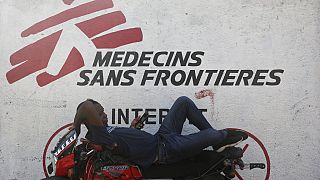Cuba
'Soy Cuba' (I am Cuba) plays at a cinema in Havana.
The 1964 movie explores the history of this nation, charting the problems faced by the people here and the island's famous revolution.
Cuba has a long obsession with the silver screen.
And that love can be seen in the bold posters used to promote films.
They were made especially for Cuba and Cubans.
Movie posters became so popular all over the island that offices, private homes, state-run restaurants and doctors' offices began to use them to decorate their walls.
Many are stored here, at the Cuban Cinemateca, a place where they can be kept in perfect condition.
Sara Vega is the curator and custodian of its posters and is proud to show the collection.
And they have recently received international recognition.
Whether colorful or abstract, pop or comic, always printed in silkscreen, the collection of Cuban movie posters from the last six decades has just been inscribed on UNESCO's Memory of the World list.
“It is a collection that gathers all genres of films from different parts. There are posters of films from Japan, China, Egypt, Sweden. Some are important (films), others less important - socialist, capitalist and, of course, Cuban posters," explains Vega, while showing some of the 3,000 posters that make up the collection.
It was 1959 when the new revolutionary authorities created the Cuban Institute of Cinematographic Art and Industry (ICAIC), one of the first organizations founded by the new government to promote the production and distribution of cinema on the island.
Directors then decided that many of the films screened would carry their own posters made by local artists.
At the time, they never imagined they would become a cultural phenomenon, where homes, workplaces and even hospitals ended up displaying them on their walls.
The idea was to create a space for local graphic artists in a place that was captive to the American film market.
Instead of promotional posters showing the faces of the stars, Cubans decided to do something different.
Artists experimented with their own view and representation of the film.
The first ICAIC film with its own poster was "Historias de la Revolución" (1960), directed by Tomás Gutiérrez Alea, a feature film whose promotional poster was designed by Eduardo Muñoz Bachs, who later became a master of the genre.
Among the most admired film poster artists are Muñoz Bachs with "Por Primera Vez"( 'For the First Time', directed by Octavio Cortazar), as well as Ernesto Ferrán who designed the poster for the famous "Fresa y Chocolate" (Oscar-nominated 'Strawberry and Chocolate' in 1993) and René Azcuy for the Francois Truffaut film "Besos Robados" ('Stolen Kisses').
“What you put out in the streets so that people go to the movies is one thing, that is promotional or advertising, which no longer exists in this country. Now, what you put in your house is what you like, what you can see every day, and does not bore you," says Vega.
"I wrote recently that when people removed from their homes, for whatever reasons, the picture of the Sacred Heart of Jesus and put a poster of (the movie) Stolen Kisses, the battle is won.”
The creators are limited by the relatively small format of the banners - about 76x51 centimeters - conditioned by the size of ICAIC's silkscreen printing machines.
The colors used depended on what paints were available, all part of Cuba's historical shortages.
Among the new generation is designer Nelson Ponce, who created the poster for "Vampires in Havana!".
For Ponce, the inclusion of Cuban film posters by UNESCO is a "well-deserved recognition" of graphic design and its creators.
"It inspires the new generations that are already working in other media, digital, in social media," he says.
"I believe that these posters have values that can be adapted to these media, such as ingenuity, graphic quality, and certain characteristics that can be revived in the contemporary context, I think they should absorb that information.”
The Memory of the World program by UNESCO is dedicated to the preservation, access and protection of the documentary heritage of mankind.













02:20
Cuba's traditional 'guayabera' shirt on the way to global icon status
02:20
A look at religious diversity in once atheist Cuba
01:20
Boxing Cuba defeats France in friendly bout ahead Paris 2024
02:20
Morocco exhibits works by Cuban artists
01:23
Afro-Cuban priests' prophecies for 2024
02:12
Cuba: "Proyecto Espejo" teaches children traditional Latin dance styles